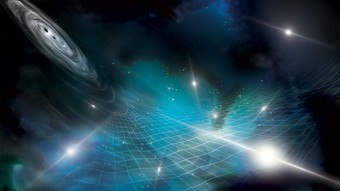Hearing the cosmic background noise emitted by giant black holes for the first time!
5 min read
Astronomers have been searching for it for 25 years and have finally found it: the cosmic noise emitted by swirling giant black holes has been identified thanks to an unprecedented technique for detecting gravitational waves that opens a ‘new window on the universe’.
The results, revealed on Thursday (29), are the result of a broad collaboration between the world’s largest radio telescopes, which have been able to capture this vibration of the universe with “clockwise precision,” a tribute to the work’s authors. Published simultaneously in several scientific journals.
Einstein predicted gravitational waves in 1916, but it can only be discovered after a hundred years. They are small disturbances in space-time, similar to the waves of water on the surface of a lake.
These oscillations, which propagate at the speed of light, arise from the impact of violent cosmic events, such as the collision of two black holes.
Although they are associated with massive phenomena, their signals are very weak. In 2015, the gravitational-wave detectors Ligo (USA) and Virgo (Europe) revolutionized astrophysics by recording a sub-second tremor in the collision between two black holes ten times the mass of the Sun.
This time, a much longer time signal teases a large-scale phenomenon, captured by a network of telescopes in Europe, North America, India, Australia and China from the Puslar Timing Array (IPTA).
“We are talking about gravitational waves generated by black holes from several million to several billion solar masses,” Gilles Thoreau, an astronomer at the Paris Observatory PSL, told AFP.
Tic Tac Pulsars
To detect these waves, scientists used a new tool: the Milky Way’s pulsars. They are stars with a mass of one or two times the mass of the Sun, but compressed into a ball about 10 kilometers in diameter.
They are very compact, and they rotate around themselves very quickly, up to 700 revolutions per second, explains the researcher at the National Center for Scientific Research (CNRS).
This runaway rotation produces magnetic radiation at its poles, which is like a beam of light from a lighthouse, and can be detected thanks to the radio waves emitted at low frequency.
With every turn, pulsars emit super-regular “beeps,” which stand out as “wonderful natural clocks,” explains Lucas Guillemot of the Laboratory for Physics and Chemistry of the Environment and Space (LPC2E) in Orleans.
Scientists have classified groups of pulsars to obtain a “celestial web” in the complexities of space-time.
They were able to measure a small perturbation in TikTok, with “changes of less than a millionth of a second over more than 20 years,” according to Antoine Petito of the French Atomic Energy Commission (CEA).
These delays are interrelated, and are a sign of “a disturbance common to all pulsars”: the characteristic signature of gravitational waves, Gilles Thoreau explains.
Like a busy restaurant
What is the origin of these waves? The main hypothesis, Thoreau notes, is that pairs of supermassive black holes, each larger than our solar system, are “ready to collide.”
Antoine Petito describes two giants “orbiting each other before merging”, a dance that causes gravitational waves “for a period of several months to several years”.
Constant background noise Michael Keith of the European network EPTA (European Pulse Timing Array) compares to “a busy restaurant with lots of people talking around you”.
Measurements still don’t allow us to say whether this noise triggers the presence of several pairs of black holes or an entire group. Another hypothesis suggests an origin in the early years of the universe, known as the inflationary period.
“We open a new window on the universe,” says Thoreau. “We’ve added a new range of information vectors,” Pettito says, complementing the searches in Ligo and Virgo, which operate at different wavelengths.
This could shed light, among other functions, on the mystery of the formation of supermassive black holes.
Read below: Discover 10 incredible facts about the historic image of a black hole

“Entrepreneur. Music enthusiast. Lifelong communicator. General coffee aficionado. Internet scholar.”

:strip_icc()/s04.video.glbimg.com/x720/11792055.jpg)

:strip_icc()/s03.video.glbimg.com/x720/11786998.jpg)



